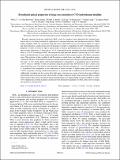| dc.contributor.author | Li, Wei | |
| dc.contributor.author | Birdwell, A. Glen | |
| dc.contributor.author | Amani, Matin | |
| dc.contributor.author | Burke, Robert A. | |
| dc.contributor.author | Ling, Xi | |
| dc.contributor.author | Lee, Yi-Hsien | |
| dc.contributor.author | Liang, Xuelei | |
| dc.contributor.author | Peng, Lianmao | |
| dc.contributor.author | Richter, Curt A. | |
| dc.contributor.author | Kong, Jing | |
| dc.contributor.author | Gundlach, David J. | |
| dc.contributor.author | Nguyen, N. V. | |
| dc.date.accessioned | 2014-11-26T18:16:59Z | |
| dc.date.available | 2014-11-26T18:16:59Z | |
| dc.date.issued | 2014-11 | |
| dc.date.submitted | 2014-09 | |
| dc.identifier.issn | 1098-0121 | |
| dc.identifier.issn | 1550-235X | |
| dc.identifier.uri | http://hdl.handle.net/1721.1/91935 | |
| dc.description.abstract | Recently emerging large-area single-layer MoS[subscript 2] grown by chemical vapor deposition has triggered great interest due to its exciting potential for applications in advanced electronic and optoelectronic devices. Unlike gapless graphene, MoS[subscript 2] has an intrinsic band gap in the visible which crosses over from an indirect to a direct gap when reduced to a single atomic layer. In this paper, we report a comprehensive study of fundamental optical properties of MoS[subscript 2] revealed by optical spectroscopy of Raman, photoluminescence, and vacuum ultraviolet spectroscopic ellipsometry. A band gap of 1.42 eV is determined by the absorption threshold of bulk MoS[subscript 2] that shifts to 1.83 eV in monolayer MoS[subscript 2]. We extracted the high precision dielectric function up to 9.0 eV, which leads to the identification of many unique interband transitions at high symmetry points in the MoS[subscript 2] momentum space. The positions of the so-called A and B excitons in single layers are found to shift upwards in energy compared with those of the bulk form and have smaller separation because of the decreased interactions between the layers. A very strong optical critical point predicted to correspond to a quasiparticle gap is observed at 2.86 eV, which is attributed to optical transitions along the parallel bands between the M and Γ points in the reduced Brillouin zone. The absence of the bulk MoS[subscript 2] spin-orbit interaction peak at ~3.0 eV in monolayer MoS[subscript 2] is, as predicted, the consequence of the coalescence of nearby excitons. A higher energy optical transition at 3.98 eV, commonly occurring in bulk semiconductors, is associated with a combination of several critical points. Additionally, extending into the vacuum ultraviolet energy spectrum are a series of newly observed oscillations representing optical transitions from valence bands to higher conduction bands of the monolayer MoS[subscript 2] complex band structure. These optical transitions herein reported enhance our understanding of monolayer MoS[subscript 2] as well as of two-dimensional systems in general and thus provide informative guidelines for MoS[subscript 2] optical device designs and theoretical considerations. | en_US |
| dc.description.sponsorship | China. Ministry of Science and Technology (Grant 2011CB921904) | en_US |
| dc.description.sponsorship | China. Ministry of Education (Grant 113003A) | en_US |
| dc.description.sponsorship | National Natural Science Foundation (China) (Grant 61321001) | en_US |
| dc.description.sponsorship | Municipal Science & Technology Commission. Beijing Natural Science Foundation (grant Z141100003814006) | en_US |
| dc.description.sponsorship | National Science Foundation (U.S.) (STC Center for Integrated Quantum Materials Grant DMR-1231319) | en_US |
| dc.publisher | American Physical Society | en_US |
| dc.relation.isversionof | http://dx.doi.org/10.1103/PhysRevB.90.195434 | en_US |
| dc.rights | Article is made available in accordance with the publisher's policy and may be subject to US copyright law. Please refer to the publisher's site for terms of use. | en_US |
| dc.source | American Physical Society | en_US |
| dc.title | Broadband optical properties of large-area monolayer CVD molybdenum disulfide | en_US |
| dc.type | Article | en_US |
| dc.identifier.citation | Li, Wei et al. “Broadband Optical Properties of Large-Area Monolayer CVD Molybdenum Disulfide.” Physical Review B 90.19 (2014): n. pag. © 2014 American Physical Society | en_US |
| dc.contributor.department | Massachusetts Institute of Technology. Department of Electrical Engineering and Computer Science | en_US |
| dc.contributor.department | Massachusetts Institute of Technology. Research Laboratory of Electronics | en_US |
| dc.contributor.mitauthor | Ling, Xi | en_US |
| dc.contributor.mitauthor | Lee, Yi-Hsien | en_US |
| dc.contributor.mitauthor | Kong, Jing | en_US |
| dc.relation.journal | Physical Review B | en_US |
| dc.eprint.version | Final published version | en_US |
| dc.type.uri | http://purl.org/eprint/type/JournalArticle | en_US |
| eprint.status | http://purl.org/eprint/status/PeerReviewed | en_US |
| dc.date.updated | 2014-11-21T23:00:20Z | |
| dc.language.rfc3066 | en | |
| dc.rights.holder | American Physical Society | |
| dspace.orderedauthors | Li, Wei; Birdwell, A. Glen; Amani, Matin; Burke, Robert A.; Ling, Xi; Lee, Yi-Hsien; Liang, Xuelei; Peng, Lianmao; Richter, Curt A.; Kong, Jing; Gundlach, David J.; Nguyen, N. V. | en_US |
| dc.identifier.orcid | https://orcid.org/0000-0002-1955-3081 | |
| dc.identifier.orcid | https://orcid.org/0000-0003-0551-1208 | |
| mit.license | PUBLISHER_POLICY | en_US |
| mit.metadata.status | Complete | |
